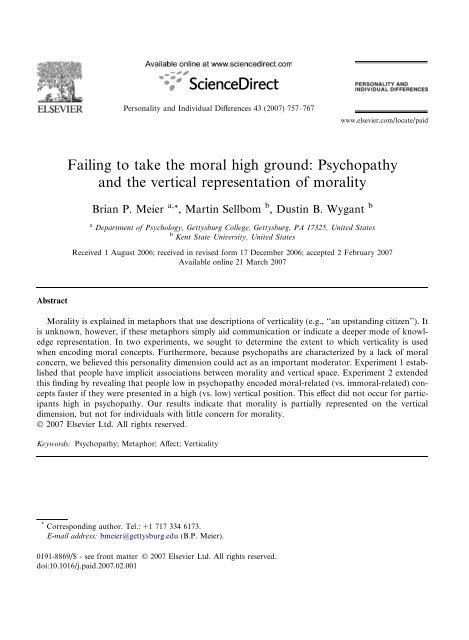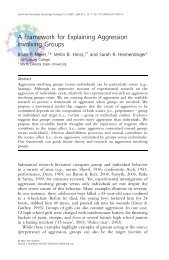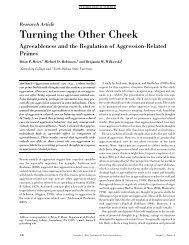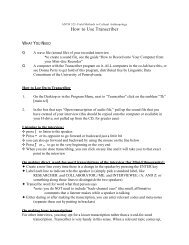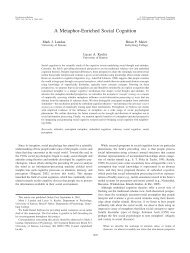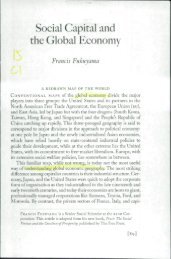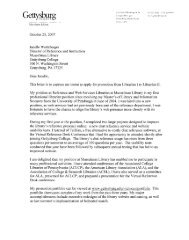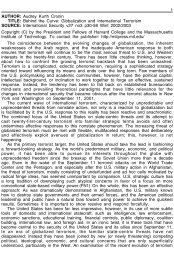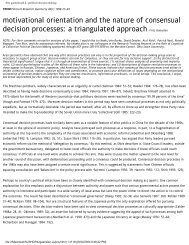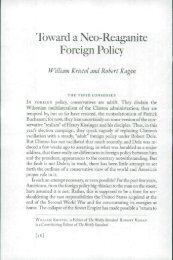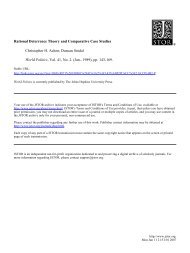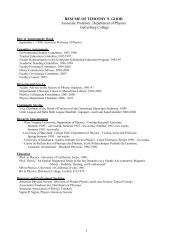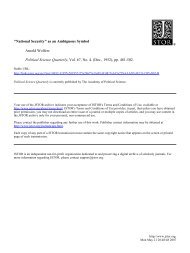Failing to take the moral high ground: Psychopathy and the vertical ...
Failing to take the moral high ground: Psychopathy and the vertical ...
Failing to take the moral high ground: Psychopathy and the vertical ...
Create successful ePaper yourself
Turn your PDF publications into a flip-book with our unique Google optimized e-Paper software.
Abstract<br />
Personality <strong>and</strong> Individual Differences 43 (2007) 757–767<br />
<strong>Failing</strong> <strong>to</strong> <strong>take</strong> <strong>the</strong> <strong>moral</strong> <strong>high</strong> <strong>ground</strong>: <strong>Psychopathy</strong><br />
<strong>and</strong> <strong>the</strong> <strong>vertical</strong> representation of <strong>moral</strong>ity<br />
Brian P. Meier a, *, Martin Sellbom b , Dustin B. Wygant b<br />
a Department of Psychology, Gettysburg College, Gettysburg, PA 17325, United States<br />
b Kent State University, United States<br />
Received 1 August 2006; received in revised form 17 December 2006; accepted 2 February 2007<br />
Available online 21 March 2007<br />
Morality is explained in metaphors that use descriptions of <strong>vertical</strong>ity (e.g., ‘‘an upst<strong>and</strong>ing citizen’’). It<br />
is unknown, however, if <strong>the</strong>se metaphors simply aid communication or indicate a deeper mode of knowledge<br />
representation. In two experiments, we sought <strong>to</strong> determine <strong>the</strong> extent <strong>to</strong> which <strong>vertical</strong>ity is used<br />
when encoding <strong>moral</strong> concepts. Fur<strong>the</strong>rmore, because psychopaths are characterized by a lack of <strong>moral</strong><br />
concern, we believed this personality dimension could act as an important modera<strong>to</strong>r. Experiment 1 established<br />
that people have implicit associations between <strong>moral</strong>ity <strong>and</strong> <strong>vertical</strong> space. Experiment 2 extended<br />
this finding by revealing that people low in psychopathy encoded <strong>moral</strong>-related (vs. im<strong>moral</strong>-related) concepts<br />
faster if <strong>the</strong>y were presented in a <strong>high</strong> (vs. low) <strong>vertical</strong> position. This effect did not occur for participants<br />
<strong>high</strong> in psychopathy. Our results indicate that <strong>moral</strong>ity is partially represented on <strong>the</strong> <strong>vertical</strong><br />
dimension, but not for individuals with little concern for <strong>moral</strong>ity.<br />
Ó 2007 Elsevier Ltd. All rights reserved.<br />
Keywords: <strong>Psychopathy</strong>; Metaphor; Affect; Verticality<br />
* Corresponding author. Tel.: +1 717 334 6173.<br />
E-mail address: bmeier@gettysburg.edu (B.P. Meier).<br />
0191-8869/$ - see front matter Ó 2007 Elsevier Ltd. All rights reserved.<br />
doi:10.1016/j.paid.2007.02.001<br />
www.elsevier.com/locate/paid
758 B.P. Meier et al. / Personality <strong>and</strong> Individual Differences 43 (2007) 757–767<br />
1. Introduction<br />
Morality is an abstract concept used <strong>to</strong> describe behavior or beliefs that an individual considers<br />
<strong>to</strong> be right <strong>and</strong> <strong>moral</strong> (e.g., fairness) or wrong <strong>and</strong> im<strong>moral</strong> (e.g., in<strong>to</strong>lerance; Haidt & Algoe,<br />
2004; Lakoff & Johnson, 1999). When discussing <strong>moral</strong>ity, people make use of metaphors that<br />
tap <strong>vertical</strong> space (i.e., <strong>moral</strong> is up; im<strong>moral</strong> is down). For example, a person who is <strong>moral</strong> might<br />
be described as ‘‘<strong>high</strong> minded’’ or ‘‘on <strong>the</strong> up <strong>and</strong> up,’’ whereas a person who is im<strong>moral</strong> might be<br />
described as ‘‘down <strong>and</strong> dirty’’ or ‘‘underh<strong>and</strong>ed’’ (Lakoff & Johnson, 1999).<br />
One reason metaphors for <strong>moral</strong>ity use descriptions of <strong>vertical</strong> space is likely because <strong>moral</strong>ity<br />
is an abstract concept. Lakoff <strong>and</strong> Johnson (1999) <strong>and</strong> Gibbs (2006) contend that abstract thought<br />
is possible because of our capacity for metaphor representation. They believe that metaphors<br />
allow people <strong>to</strong> communicate <strong>and</strong> represent (i.e., <strong>to</strong> depict or make sense of) abstract concepts<br />
that would o<strong>the</strong>rwise have no reference <strong>to</strong> physicality. In many contexts, we learn about what<br />
things are like through our senses. For example, cherries are red <strong>and</strong> taste sweet, whereas snowflakes<br />
are cold <strong>and</strong> make us wet. Morality is different in that it cannot be directly perceived<br />
through <strong>the</strong> senses. Thus, <strong>to</strong> appreciate <strong>the</strong> nature of <strong>moral</strong>ity, it makes sense that people use<br />
metaphors when describing it.<br />
Lakoff <strong>and</strong> Johnson (1999) fur<strong>the</strong>r contend that human thought processes are structured on<br />
metaphors. The manner in which people encode, s<strong>to</strong>re, <strong>and</strong> retrieve information is <strong>ground</strong>ed in<br />
metaphors. Thus, metaphors are not simply communication devices, but are used <strong>to</strong> represent<br />
concepts. That is, thinking about abstract concepts is not possible without activating or simulating<br />
<strong>the</strong> sensations <strong>and</strong> perceptions relevant <strong>to</strong> metaphor.<br />
More generally, a number of researchers argue for an embodied mode of cognition. Proponents<br />
of this view contend that cognition, ra<strong>the</strong>r than being abstract <strong>and</strong> amodal, is inherently linked <strong>to</strong><br />
sensation <strong>and</strong> perception (e.g., Niedenthal, Barsalou, Winkielman, & Krauth-Gruber, 2005). In<br />
this view, cognition is not a process that is separated from bodily states, but involves <strong>the</strong> simulation<br />
of modality-specific actions.<br />
Meier <strong>and</strong> Robinson (2004) presented evidence for an embodied mode of cognition in <strong>the</strong> affective<br />
realm. They examined <strong>the</strong> metaphor that ties affect <strong>to</strong> <strong>vertical</strong>ity (i.e., good is up; bad is<br />
down). For example, good things are described as being up (e.g., ‘‘thumbs up’’ for a good movie)<br />
<strong>and</strong> bad things are described as being down (e.g., ‘‘thumbs down’’ for a bad movie). Meier <strong>and</strong><br />
Robinson (2004) found that participants evaluated words with a positive meaning faster if <strong>the</strong>y<br />
were presented in a <strong>high</strong> <strong>vertical</strong> position, whereas participants evaluated words with a negative<br />
meaning faster if <strong>the</strong>y were presented in a low <strong>vertical</strong> position. Participants encoded <strong>the</strong> <strong>vertical</strong><br />
location of <strong>the</strong> words even though it was unnecessary for <strong>the</strong> task. This research indicates that<br />
people partially represent affect on a <strong>vertical</strong> dimension. That is, when encoding good <strong>and</strong> bad<br />
stimuli, people simulate perceptions of <strong>vertical</strong> space. Thus, it appears that <strong>vertical</strong> space is a perceptual<br />
cue for affect. In <strong>the</strong> current context, we seek <strong>to</strong> determine if <strong>moral</strong>ity is similarly represented<br />
on this same <strong>vertical</strong> dimension.<br />
1.1. <strong>Psychopathy</strong> <strong>and</strong> <strong>moral</strong>ity<br />
In addition <strong>to</strong> examining <strong>moral</strong>ity <strong>and</strong> <strong>vertical</strong> space, a central purpose of <strong>the</strong> current project is<br />
<strong>to</strong> explore <strong>the</strong> role of individual differences. Little if any research has examined <strong>the</strong> extent <strong>to</strong> which
individual differences moderate <strong>the</strong> embodiment of concepts. Although <strong>the</strong>orists might consider<br />
embodiment <strong>to</strong> be a fundamental process (e.g., Niedenthal et al., 2005), it is reasonable <strong>to</strong> assume<br />
that personality differences exist. More specifically, it might be that concepts not central <strong>to</strong> one’s<br />
personality are not embodied or represented <strong>to</strong> a great extent. If an individual does not frequently<br />
invoke a concept, <strong>the</strong>n it seems likely that this concept would not need representation. In <strong>the</strong> present<br />
case, <strong>moral</strong>ity is one such concept that individuals <strong>high</strong> in psychopathy seem <strong>to</strong> have little use<br />
for. <strong>Psychopathy</strong> is typically described as a cluster of personality characteristics <strong>and</strong> behaviors,<br />
including gr<strong>and</strong>iosity, manipulativeness, impulsivity/norm-violation, <strong>and</strong> a lack of empathy or remorse<br />
(e.g., Cleckley, 1941; Hare, 1996). His<strong>to</strong>rically, some have suggested that im<strong>moral</strong>ity is a<br />
primary underlying characteristic (Krafft-Ebing, 1904).<br />
Research reveals that psychopathy can be characterized on a continuous dimension (e.g.,<br />
Edens, Marcus, Lilienfeld, & Poythress, 2006) that includes individuals at <strong>the</strong> <strong>high</strong> extreme<br />
(e.g., violent offenders, Hare, 1991, 1996). Although individuals in non-institutional samples<br />
(e.g., college students) have a lower central distribution of scores on this dimension than prison<br />
inmates, individual differences at this level are none<strong>the</strong>less meaningful. For instance, researchers<br />
have found that psychopathy can be successfully conceptualized in normal personality space (Benning,<br />
Patrick, Hicks, Blonigen, & Krueger, 2003).<br />
Psychopaths appear <strong>to</strong> be deficient in processing affective stimuli. For example, Williamson,<br />
Harpur, <strong>and</strong> Hare (1991) found that people <strong>high</strong> (vs. low) in psychopathy had less behavioral<br />
<strong>and</strong> neural response differences when processing words with an affective versus neutral meaning.<br />
Herve, Hayes, <strong>and</strong> Hare (2003) found that people <strong>high</strong> (vs. low) in psychopathy had difficultly<br />
determining <strong>the</strong> valence of metaphoric statements. For example, one psychopath rated <strong>the</strong> statement<br />
‘‘love is an antidote for <strong>the</strong> world’s ills’’ as strongly negative.<br />
1.2. The present experiments<br />
In <strong>the</strong> present experiments, we examined whe<strong>the</strong>r this deficiency would extend <strong>to</strong> affectiveknowledge<br />
representation. A lack of <strong>moral</strong> concern is one characteristic of psychopathy. Therefore,<br />
we expected that psychopathy would impact <strong>the</strong> extent <strong>to</strong> which <strong>moral</strong>ity is represented on<br />
<strong>the</strong> <strong>vertical</strong> dimension. That is, it might be that people who are not concerned about <strong>moral</strong>ity do<br />
not use <strong>vertical</strong> cues <strong>to</strong> represent it. In Experiment 1, we first sought <strong>to</strong> determine if people have<br />
implicit associations between <strong>moral</strong>ity <strong>and</strong> <strong>vertical</strong> space. In Experiment 2, we examined <strong>the</strong> potential<br />
moderating impact of psychopathy.<br />
2. Experiment 1<br />
B.P. Meier et al. / Personality <strong>and</strong> Individual Differences 43 (2007) 757–767 759<br />
We used an implicit association test (IAT; Greenwald, McGhee, & Schwartz, 1998) <strong>to</strong> examine<br />
<strong>the</strong> association between <strong>moral</strong>ity <strong>and</strong> <strong>vertical</strong>ity. The IAT assesses associations in an implicit<br />
manner by requiring participants <strong>to</strong> categorize stimuli as belonging <strong>to</strong> one of four concepts.<br />
For example, Greenwald et al. (1998) had people categorize words from four categories: insects,<br />
flowers, pleasant, <strong>and</strong> unpleasant. The trials of interest occur when two category names are<br />
mapped on<strong>to</strong> one but<strong>to</strong>n. These researchers found that participants were faster <strong>to</strong> categorize
760 B.P. Meier et al. / Personality <strong>and</strong> Individual Differences 43 (2007) 757–767<br />
words when insect/unpleasant were mapped on<strong>to</strong> one but<strong>to</strong>n <strong>and</strong> flower/pleasant were mapped<br />
on<strong>to</strong> ano<strong>the</strong>r (ra<strong>the</strong>r than <strong>the</strong> reverse).<br />
In Experiment 1, participants categorized words as having ei<strong>the</strong>r a <strong>moral</strong> or im<strong>moral</strong> meaning<br />
<strong>and</strong> <strong>the</strong>y categorized a cue (***) as appearing ei<strong>the</strong>r above or below screen center. We predicted<br />
that participants would have implicit associations between <strong>moral</strong>ity <strong>and</strong> ‘‘up’’ <strong>and</strong> im<strong>moral</strong>ity <strong>and</strong><br />
‘‘down.’’ Such results would provide evidence that <strong>the</strong> <strong>vertical</strong> dimension is invoked during <strong>the</strong><br />
encoding of <strong>moral</strong> concepts.<br />
2.1. Method<br />
2.1.1. Participants<br />
Participants were 69 undergraduates (17 males) with an average age of 19.19 years (SD = 1.32<br />
years).<br />
2.1.2. Materials <strong>and</strong> procedure<br />
Word stimuli. We selected five words with a <strong>moral</strong> meaning (caring, charity, nurture, truthful,<br />
<strong>and</strong> trustworthy) <strong>and</strong> five words with an im<strong>moral</strong> meaning (adultery, corrupt, dishonest, evil, <strong>and</strong><br />
molest). The number of letters <strong>and</strong> frequency did not differ, Fs < 1. Twelve individuals (not in<br />
ei<strong>the</strong>r experiment) rated <strong>the</strong> extent <strong>to</strong> which each word had an im<strong>moral</strong> or <strong>moral</strong> meaning (1 =<br />
extremely im<strong>moral</strong>; 9 = extremely <strong>moral</strong>). Using word as <strong>the</strong> unit of analysis, <strong>the</strong> <strong>moral</strong> words<br />
(M = 8.02; SD = 0.11) were rated as having a significantly more <strong>moral</strong> meaning than <strong>the</strong> im<strong>moral</strong><br />
words (M = 2.08; SD = 0.24), F(1,8) = 2522.58, p < 0.001, g2 p ¼ 1:00.<br />
IAT. The IAT was comprised of two categorizations. One, participants categorized <strong>the</strong> words<br />
as referring <strong>to</strong> an im<strong>moral</strong> or <strong>moral</strong> behavior/concept as <strong>the</strong> words r<strong>and</strong>omly appeared in <strong>the</strong> center<br />
of a 19-in. computer screen (in green, 16-point Arial font). Two, participants categorized a cue<br />
(three asterisks: ***) as it appeared 1 in. above or below <strong>the</strong> center of <strong>the</strong> screen (in green, 20-<br />
Point Arial font).<br />
Participants were asked <strong>to</strong> perform quick <strong>and</strong> accurate categorizations. Category names (im<strong>moral</strong>,<br />
<strong>moral</strong>, up, down) appeared on <strong>the</strong> upper left <strong>and</strong> right of <strong>the</strong> screen (in white, 16-point<br />
Arial font). Participants were <strong>to</strong>ld <strong>to</strong> press <strong>the</strong> ‘‘Q’’ key if <strong>the</strong> word or cue belonged <strong>to</strong> <strong>the</strong> category<br />
on <strong>the</strong> upper left <strong>and</strong> <strong>to</strong> press <strong>the</strong> ‘‘P’’ key if <strong>the</strong> word or cue belonged <strong>to</strong> <strong>the</strong> category on <strong>the</strong> upper<br />
right. Incorrect categorizations were followed by <strong>the</strong> word ‘‘INCORRECT’’ in red for 1.5 s. Correct<br />
categorizations were followed by a 150 ms blank screen. The words <strong>and</strong> cues remained on <strong>the</strong><br />
screen until participants responded.<br />
The IAT included several practice blocks, but <strong>the</strong> main interest was two experimental blocks:<br />
(1) 40 trials for <strong>the</strong> combined categories (<strong>moral</strong> or up/im<strong>moral</strong> or down); (2) 40 trials for <strong>the</strong> reverse<br />
combined categories (im<strong>moral</strong> or up/<strong>moral</strong> or down). The presentation of <strong>the</strong>se blocks was<br />
counter balanced.<br />
2.1.3. Results <strong>and</strong> discussion<br />
We followed <strong>the</strong> data reduction procedure of Greenwald et al. (1998): deletion of <strong>the</strong> first two<br />
trials, replacement of trials below 300 ms <strong>and</strong> above 3000 ms, deletion of inaccurate trials (3.13%),<br />
<strong>and</strong> a log-transformation of <strong>the</strong> latencies. Analyses were performed on log-transformed latencies,<br />
but means are reported in milliseconds.
We conducted a mixed-model ANOVA with two fac<strong>to</strong>rs. The between-fac<strong>to</strong>r pertained <strong>to</strong> IAT<br />
Order (<strong>moral</strong> + up/im<strong>moral</strong> + down in <strong>the</strong> first combined block vs. im<strong>moral</strong> + up/<strong>moral</strong> + down<br />
in <strong>the</strong> first combined block). The within-fac<strong>to</strong>r pertained <strong>to</strong> IAT Block (<strong>moral</strong> + up/im<strong>moral</strong> +<br />
down vs. im<strong>moral</strong> + up/<strong>moral</strong> + down). The main effect of IAT Order was not significant,<br />
F < 1. The main effect of IAT Block, F(1,67) = 68.88, p < 0.001, g2 p ¼ 0:51, <strong>and</strong> <strong>the</strong> IAT Block<br />
by IAT Order interaction, F(1,67) = 8.21, p = 0.006, g2 p ¼ 0:11, were significant. The main effect<br />
of IAT Block revealed that participants were faster at categorizing <strong>the</strong> <strong>moral</strong> words when <strong>the</strong>y were<br />
paired with <strong>the</strong> asterisks that appeared up <strong>and</strong> <strong>the</strong> im<strong>moral</strong> words when <strong>the</strong>y were paired with<br />
asterisks that appeared down (M = 748 ms; SD = 150 ms) ra<strong>the</strong>r than when <strong>the</strong>se pairings were<br />
reversed (M = 887 ms; SD = 202 ms). The IAT Order by IAT Block interaction indicated <strong>the</strong><br />
IAT Block effect was stronger when <strong>the</strong> first combined block included <strong>moral</strong> + up <strong>and</strong> im<strong>moral</strong> +<br />
down ðg2 p ¼ 0:75Þ ra<strong>the</strong>r than <strong>the</strong> reverse ðg2 p ¼ 0:24Þ.<br />
The results of Experiment 1 indicate that people have associations in memory between <strong>the</strong> concepts<br />
of <strong>moral</strong>ity <strong>and</strong> <strong>vertical</strong> space. These results establish that people associate <strong>moral</strong>ity with<br />
areas of <strong>vertical</strong> space in <strong>the</strong> absence of figurative utterances.<br />
3. Experiment 2<br />
Experiment 2 had two goals: (1) we wanted <strong>to</strong> replicate Experiment 1 with a task that did not<br />
use <strong>vertical</strong> descrip<strong>to</strong>rs (‘‘up’’ or ‘‘down’’), <strong>and</strong> (2) we wanted <strong>to</strong> investigate <strong>the</strong> potential moderating<br />
role of psychopathy. Participants were asked <strong>to</strong> categorize words as having a <strong>moral</strong> or<br />
im<strong>moral</strong> meaning as <strong>the</strong> words r<strong>and</strong>omly appeared near <strong>the</strong> <strong>to</strong>p or bot<strong>to</strong>m of a screen. After<br />
<strong>the</strong> completion of this task, participants completed Levenson’s Self-Reported <strong>Psychopathy</strong> scale<br />
(LSRP; Levenson, Kiehl, & Fitzpatrick, 1995). We expected that <strong>vertical</strong> space would interact<br />
with word type such that participants would be faster <strong>to</strong> categorize a word with a <strong>moral</strong> meaning<br />
when it was presented on <strong>to</strong>p (vs. bot<strong>to</strong>m) whereas <strong>the</strong> reverse should occur for words with an<br />
im<strong>moral</strong> meaning. Fur<strong>the</strong>rmore, because a lack of <strong>moral</strong> concern is one defining feature of psychopathy,<br />
we believed that this effect might not occur for participants <strong>high</strong> in psychopathy.<br />
3.1. Method<br />
B.P. Meier et al. / Personality <strong>and</strong> Individual Differences 43 (2007) 757–767 761<br />
3.1.1. Participants<br />
Participants were 112 undergraduates (59 males) with an average age of 19.48 years (SD = 2.60<br />
years).<br />
3.1.2. Materials <strong>and</strong> procedures<br />
Word stimuli. We used <strong>the</strong> same ten words from Experiment 1 <strong>and</strong> we selected 32 additional<br />
words. 1 The words were similar in number of letters <strong>and</strong> frequency, Fs < 1. The same 12 individuals<br />
1 Additional <strong>moral</strong> words were: assist, donate, empathy, ethical, fairness, generous, goodness, goodwill, honesty,<br />
honorable, integrity, kindness, noble, respectful, virtue, <strong>and</strong> volunteer. Additional im<strong>moral</strong> words were: bribe, crooked,<br />
deceit, hurt, indecent, lying, manipulate, merciless, perverted, prostitution, ruthless, shoplift, sinfulness, villainous,<br />
violate, <strong>and</strong> wicked.
762 B.P. Meier et al. / Personality <strong>and</strong> Individual Differences 43 (2007) 757–767<br />
from Experiment 1 rated <strong>the</strong> <strong>moral</strong> words (M = 7.37; SD = 0.47) as having a significantly more<br />
<strong>moral</strong> meaning than <strong>the</strong> im<strong>moral</strong> words (M = 2.53; SD = 0.52), F(1,40) = 986.64, p < 0.001,<br />
g2 p ¼ 0:96.<br />
Categorization task. Participants categorized <strong>the</strong> words as referring <strong>to</strong> a behavior/concept that<br />
was <strong>moral</strong> or im<strong>moral</strong>. A r<strong>and</strong>omly chosen word r<strong>and</strong>omly appeared approximately one-quarter<br />
of an inch from <strong>the</strong> <strong>to</strong>p or bot<strong>to</strong>m of a 19-in. screen (in white, 22-point Arial font). Each word was<br />
presented three times (all words were shown before a repetition began). Thus, <strong>the</strong>re were 126 trials<br />
with approximately 31 trials in each condition (i.e., <strong>moral</strong>/up, <strong>moral</strong>/down, im<strong>moral</strong>/up, im<strong>moral</strong>/<br />
down).<br />
Each trial began with <strong>the</strong> presentation of a small white circle in <strong>the</strong> screen center for 300 ms.<br />
Participants were <strong>to</strong> attend <strong>to</strong> this circle. After <strong>the</strong> circle disappeared, a blank screen appeared<br />
for 300 ms. Then, a r<strong>and</strong>omly chosen word r<strong>and</strong>omly appeared near <strong>the</strong> <strong>to</strong>p or bot<strong>to</strong>m of <strong>the</strong><br />
screen. Participants were <strong>to</strong> press <strong>the</strong> ‘‘Q’’ key for words with a <strong>moral</strong> meaning <strong>and</strong> <strong>to</strong> press<br />
<strong>the</strong> ‘‘P’’ key for words with an im<strong>moral</strong> meaning. If participants were correct, a 500 ms blank<br />
screen appeared until <strong>the</strong> next trial. If participants were incorrect, <strong>the</strong> word INCORRECT was<br />
shown in red for 1.5 s before <strong>the</strong> next trial. The word remained on <strong>the</strong> screen until participants<br />
pressed a key.<br />
Levenson’s Self-Reported <strong>Psychopathy</strong> scale. (LSRP; Levenson et al., 1995). Participants completed<br />
<strong>the</strong> LSRP after <strong>the</strong> categorization task. The LSRP includes 26 items (e.g., for me, what’s<br />
right is whatever I can get away with) answered on a scale from 1 (strongly disagree) <strong>to</strong> 4 (strongly<br />
agree). The LSRP has two subscales (primary <strong>and</strong> secondary), but a <strong>to</strong>tal score consisting of an<br />
average of all items is typically used (which is what we used in <strong>the</strong> current experiment; a = 0.83).<br />
Research suggests that this measure is at least moderately correlated with Hare’s (1991) psychopathy<br />
checklist-revised (PCL-R; Brinkley, Schmitt, Smith, & Newman, 2001).<br />
3.1.3. Results <strong>and</strong> discussion<br />
For <strong>the</strong> categorization task, we deleted inaccurate trials (4.5% of trials), log-transformed correct<br />
trials, <strong>and</strong> replaced trials above <strong>and</strong> below 2.5 SDs (with <strong>the</strong> 2.5 SD value; 3.0% of trials;<br />
Robinson, in press). Analyses were conducted on log-transformed latencies, but means are reported<br />
in milliseconds.<br />
We performed a 2 (word type: im<strong>moral</strong> or <strong>moral</strong>) by 2 (word position: up or down) repeatedmeasures<br />
ANOVA with psychopathy entered as a covariate (z-scores). The main effect of Word<br />
Type was significant, F(1,110) = 78.99, p < 0.001, g2 p = 0.42. Participants were faster <strong>to</strong> categorize<br />
<strong>the</strong> <strong>moral</strong> words (M = 919 ms; SD = 145 ms) than <strong>the</strong> im<strong>moral</strong> words (M = 968 ms; SD =<br />
164 ms). The main effect of Word Position was significant, F(1,110) = 49.83, p < 0.001, g2 p = 0.31.<br />
Participants were faster <strong>to</strong> categorize words appearing on <strong>to</strong>p (M = 925 ms; SD = 153 ms) than<br />
on <strong>the</strong> bot<strong>to</strong>m (M = 963 ms; SD = 157 ms). The main effect of <strong>Psychopathy</strong> as well as <strong>the</strong> interactions<br />
between Word Type <strong>and</strong> <strong>Psychopathy</strong> <strong>and</strong> Word Position <strong>and</strong> <strong>Psychopathy</strong> were non-significant,<br />
Fs < 1.9.<br />
The interaction between Word Type <strong>and</strong> Word Position was significant, F(1,110) = 11.23,<br />
p = 0.001, g2 p ¼ 0:09. As shown in Table 1, participants were faster <strong>to</strong> categorize both word types<br />
when words appeared near <strong>the</strong> <strong>to</strong>p (vs. <strong>the</strong> bot<strong>to</strong>m), but this effect was more pronounced for<br />
words with a <strong>moral</strong> meaning. This interaction was qualified by a significant three-way interaction<br />
among Word Type, Word Position, <strong>and</strong> <strong>Psychopathy</strong>, F(1,110) = 4.07, p = 0.046, g2 p ¼ 0:04. To
B.P. Meier et al. / Personality <strong>and</strong> Individual Differences 43 (2007) 757–767 763<br />
Table 1<br />
Descriptive statistics for both experiments<br />
Experiment Variable Statistic<br />
M SD<br />
1(N = 69) RT for <strong>moral</strong>-up/im<strong>moral</strong>-down 748 ms 150 ms<br />
RT for <strong>moral</strong>-down/im<strong>moral</strong>-up 887 ms 202 ms<br />
2(N = 112) RT for <strong>moral</strong>-up 895 ms 150 ms<br />
RT for <strong>moral</strong>-down 943 ms 150 ms<br />
RT for im<strong>moral</strong>-up 954 ms 165 ms<br />
RT for im<strong>moral</strong>-down 982 ms 174 ms<br />
LSRP 1.93 0.38<br />
Note. LSRP = Levenson’s Self-Reported <strong>Psychopathy</strong>.<br />
investigate this interaction, we performed a median split on <strong>the</strong> psychopathy scores <strong>and</strong> conducted<br />
a Word Type by Word Position repeated-measures ANOVA for participants scoring low <strong>and</strong> <strong>high</strong><br />
in psychopathy (seven participants at <strong>the</strong> median were excluded).<br />
For participants low in psychopathy, <strong>the</strong> main effect of Word Type was significant,<br />
F(1,54) = 31.75, p < 0.001, g2 p ¼ 0:37, indicating that participants were faster <strong>to</strong> categorize <strong>the</strong><br />
<strong>moral</strong> (M = 906 ms; SD = 144 ms) than <strong>the</strong> im<strong>moral</strong> (M = 955 ms; SD = 165 ms) words. The<br />
main effect of Word Position was significant, F(1,54) = 32.58, p < 0.001, g2 p ¼ 0:38, indicating that<br />
participants were faster <strong>to</strong> categorize words appearing near <strong>the</strong> <strong>to</strong>p (M = 909 ms; SD = 146 ms)<br />
than <strong>the</strong> bot<strong>to</strong>m (M = 952 ms; SD = 161 ms). These effects were qualified by a significant Word<br />
Type by Word Position interaction, F(1,54) = 12.46, p = 0.001, g2 p ¼ 0:19. As shown in <strong>the</strong> <strong>to</strong>p<br />
portion of Fig. 1, both word types were categorized faster when <strong>the</strong>y appeared near <strong>the</strong> <strong>to</strong>p of<br />
<strong>the</strong> screen, but this effect was more pronounced for <strong>the</strong> <strong>moral</strong> words.<br />
For participants <strong>high</strong> in psychopathy, <strong>the</strong> main effect of Word Type was significant,<br />
F(1,49) = 48.34, p < 0.001, g2 p ¼ 0:50, indicating that participants were faster <strong>to</strong> categorize <strong>the</strong><br />
<strong>moral</strong> (M = 934 ms; SD = 154 ms) than <strong>the</strong> im<strong>moral</strong> (M = 986 ms; SD = 171 ms) words. The<br />
main effect of Word Position was also significant, F(1,49) = 16.50, p < 0.001, g2 p ¼ 0:25, indicating<br />
that participants were faster <strong>to</strong> categorize words appearing near <strong>the</strong> <strong>to</strong>p (M = 943 ms;<br />
SD = 166 ms) than <strong>the</strong> bot<strong>to</strong>m (M = 976 ms; SD = 162 ms). The interaction between Word Type<br />
<strong>and</strong> Word Position was not significant, F(1,49) = 2.21, p = 0.144, g2 p ¼ 0:04. As shown in <strong>the</strong> bot<strong>to</strong>m<br />
portion of Fig. 1, both word types were similarly categorized faster when <strong>the</strong>y appeared near<br />
<strong>the</strong> <strong>to</strong>p of <strong>the</strong> screen.<br />
Experiment 2 partially replicated Experiment 1 in revealing that <strong>the</strong> speed <strong>to</strong> encode words with<br />
a <strong>moral</strong> <strong>and</strong> im<strong>moral</strong> meaning varied by <strong>vertical</strong> position. While participants categorized both<br />
word types faster when <strong>the</strong>y appeared near <strong>the</strong> <strong>to</strong>p, this effect was pronounced for <strong>moral</strong> words.<br />
Fur<strong>the</strong>rmore, as hypo<strong>the</strong>sized, participants’ psychopathy scores predicted <strong>the</strong> extent of this effect.<br />
The nature of <strong>the</strong> interaction between word type <strong>and</strong> word position for participants low in psychopathy<br />
was not exactly as expected. Participants were faster <strong>to</strong> categorize both word types when<br />
<strong>the</strong>y appeared near <strong>the</strong> <strong>to</strong>p of <strong>the</strong> screen (although <strong>the</strong> effect was stronger for <strong>moral</strong> words). It<br />
might be that <strong>vertical</strong> representation is only relevant for <strong>moral</strong> concepts. The main effect of word<br />
position, however, may have obscured an effect for im<strong>moral</strong> concepts. Main effects for word posi-
764 B.P. Meier et al. / Personality <strong>and</strong> Individual Differences 43 (2007) 757–767<br />
Mean Categorization Time (ms) Mean Categorization Time (ms)<br />
960<br />
940<br />
920<br />
900<br />
880<br />
860<br />
840<br />
820<br />
1020<br />
1000<br />
980<br />
960<br />
940<br />
920<br />
900<br />
880<br />
860<br />
Moral Im<strong>moral</strong><br />
Word Type<br />
Moral lm<strong>moral</strong><br />
Word Type<br />
Top of Screen<br />
Bot<strong>to</strong>m of Screen<br />
Top of Screen<br />
Bot<strong>to</strong>m of Screen<br />
Fig. 1. Categorization times as a function of word type <strong>and</strong> word position for individuals low (<strong>to</strong>p panel) <strong>and</strong> <strong>high</strong><br />
(bot<strong>to</strong>m panel) in psychopathy.<br />
tion occur in this research (e.g., Schubert, 2005), possibly because people have a his<strong>to</strong>ry of reading<br />
text from <strong>to</strong>p <strong>to</strong> bot<strong>to</strong>m.<br />
We wanted <strong>to</strong> determine what <strong>the</strong> interactive pattern between word type <strong>and</strong> word position<br />
would look like if we could remove <strong>the</strong> influence of <strong>the</strong> main effects. That is, what pattern would<br />
occur if we removed <strong>the</strong> tendency for people <strong>to</strong> be faster <strong>to</strong> <strong>moral</strong> words <strong>and</strong> <strong>to</strong> words that<br />
appeared near <strong>the</strong> <strong>to</strong>p? Rosnow <strong>and</strong> Rosenthal (1991) have argued that two by two interactions<br />
should be interpreted by examining residual scores. Residual scores reflect <strong>the</strong> nature of an interaction<br />
after removing <strong>the</strong> influence of significant main effects. Although we did not originally plan<br />
on examining <strong>the</strong> residual scores, this method is justified in <strong>the</strong> present case because <strong>the</strong> main<br />
effects were large, uninformative, <strong>and</strong> may have obscured <strong>the</strong> predicted interaction.<br />
To obtain residual scores, we computed <strong>the</strong> two by two cell means, <strong>the</strong> gr<strong>and</strong> mean, <strong>the</strong> row<br />
effects, <strong>and</strong> <strong>the</strong> column effects. Then, we subtracted <strong>the</strong> row effect, column effect, <strong>and</strong> gr<strong>and</strong> mean<br />
from each cell mean leaving <strong>the</strong> residual scores (Rosnow & Rosenthal, 1991). As shown in Fig. 2,<br />
<strong>the</strong>se residual scores indicate that participants low in psychopathy were faster <strong>to</strong> categorize <strong>the</strong><br />
<strong>moral</strong> words when presented near <strong>the</strong> <strong>to</strong>p, but <strong>the</strong>y were faster <strong>to</strong> categorize <strong>the</strong> im<strong>moral</strong> words<br />
when presented near <strong>the</strong> bot<strong>to</strong>m.
4. General discussion<br />
B.P. Meier et al. / Personality <strong>and</strong> Individual Differences 43 (2007) 757–767 765<br />
Residual Scores<br />
10<br />
8<br />
6<br />
4<br />
2<br />
0<br />
-2<br />
-4<br />
-6<br />
-8<br />
-10<br />
Moral Im<strong>moral</strong><br />
Word Type<br />
Top of Screen<br />
Bot<strong>to</strong>m of Screen<br />
Fig. 2. Residuals scores for <strong>the</strong> word type by word position interaction for participants low in psychopathy.<br />
Morality is often explained in metaphors that use descriptions of <strong>vertical</strong>ity. Lakoff <strong>and</strong> Johnson<br />
(1999) contend that metaphor is not simply a communication device, but it is used <strong>to</strong> represent<br />
abstract knowledge. More generally, <strong>the</strong>orists contend that our conceptual systems are<br />
embodied (Niedenthal et al., 2005). In two experiments, we found that people have implicit associations<br />
between <strong>moral</strong>ity <strong>and</strong> <strong>vertical</strong> space (Experiment 1) <strong>and</strong> that this effect might be specific<br />
<strong>to</strong> individuals low in psychopathy (Experiment 2). Our results have implications for metaphorrepresentation<br />
<strong>and</strong> psychopathy.<br />
4.1. Implications for metaphor-representation <strong>the</strong>ory <strong>and</strong> psychopathy<br />
Metaphor-representation <strong>the</strong>ory contends that abstract-knowledge representation is aided by<br />
conceptual metaphors (Lakoff & Johnson, 1999; Meier & Robinson, 2005). The current findings<br />
support this view by revealing that <strong>moral</strong> concepts are encoded faster when paired with upper<br />
visual cues or when presented in a <strong>high</strong> <strong>vertical</strong> location. More importantly, <strong>the</strong> current findings<br />
extend metaphor-representation <strong>the</strong>ory by showing that this effect was particular <strong>to</strong> people low<br />
in psychopathy. These findings suggest that <strong>the</strong>re are individual differences in metaphor representation.<br />
Specifically, it could be that concepts not central <strong>to</strong> a specific personality dimension are not<br />
represented <strong>to</strong> <strong>the</strong> same extent. Metaphor representation does not appear <strong>to</strong> be an inevitable occurrence,<br />
but might be specific <strong>to</strong> individuals who frequently invoke a concept. Future research might<br />
consider <strong>the</strong> role o<strong>the</strong>r personality dimensions (e.g., trait anger) play in <strong>the</strong> metaphorical-representation<br />
of personality-specific concepts (e.g., anger is described in metaphors that use ‘‘heat’’).<br />
Although psychopathy did not affect <strong>the</strong> speed in which <strong>moral</strong> <strong>and</strong> im<strong>moral</strong> words were categorized,<br />
psychopathy did affect <strong>the</strong> extent <strong>to</strong> which <strong>the</strong> <strong>vertical</strong> dimension was used in <strong>the</strong>se categorizations.<br />
Individuals <strong>high</strong> in psychopathy do not appear <strong>to</strong> use <strong>vertical</strong>ity as a cue when encoding<br />
<strong>moral</strong>-related concepts. These results complement research showing that psychopaths are deficient<br />
in <strong>the</strong> implicit processing of affective stimuli (e.g., Kiehl, Hare, & McDonald, 1999; Williamson,<br />
Harpur, & Hare, 1991). Because <strong>moral</strong>ity is an affectively-ladened concept, this deficiency appears<br />
<strong>to</strong> extend <strong>to</strong> knowledge-representation tasks such as <strong>the</strong> present one.
766 B.P. Meier et al. / Personality <strong>and</strong> Individual Differences 43 (2007) 757–767<br />
4.2. Caveats <strong>and</strong> additional considerations<br />
Why <strong>moral</strong>ity <strong>and</strong> <strong>vertical</strong>ity? Although we found that <strong>moral</strong>ity is partially represented on <strong>the</strong><br />
<strong>vertical</strong> dimension, our experiments do not provide a reason for this representation. The origination<br />
of this pairing is beyond <strong>the</strong> scope of this article. We can, however, provide some speculation.<br />
Considering cognitive development, Tolaas (1991) suggests that infants spend much of <strong>the</strong>ir time<br />
lying on <strong>the</strong>ir back peering up at caregivers. This low <strong>vertical</strong> position necessarily means that<br />
rewarding stimuli (e.g., food) <strong>and</strong> <strong>moral</strong> behavior (e.g., love) arrive from a <strong>high</strong> <strong>vertical</strong> position.<br />
A child’s caregiver frequently appears in <strong>the</strong> infant’s upper visual-spatial environment. As cognition<br />
matures, humans use this sensorimo<strong>to</strong>r scaffolding <strong>to</strong> develop abstract thought, as recognized<br />
by developmental psychologists (e.g., Piaget & Inhelder, 1969). This early pairing leads adults <strong>to</strong><br />
use <strong>the</strong> <strong>vertical</strong> dimension when expressing <strong>and</strong> representing <strong>moral</strong>ity (Lakoff & Johnson, 1999).<br />
These considerations suggest that <strong>the</strong> association between <strong>moral</strong>ity <strong>and</strong> <strong>vertical</strong> position may<br />
develop early within one’s sensory experiences (see Gibbs, 2006; for additional considerations).<br />
Assessing psychopathy. We used <strong>the</strong> LSRP (Levenson et al., 1995) <strong>to</strong> assess psychopathy because<br />
we wanted a quick <strong>and</strong> reasonably valid measure. Although Brinkley et al. (2001) showed that this<br />
scale was moderately correlated with Hare’s (1991) PCL-R, it is clear that <strong>the</strong>se measures are not<br />
tapping exactly <strong>the</strong> same construct. In particular, Brinkley et al. (2001) showed that <strong>the</strong> LSRP <strong>and</strong><br />
<strong>the</strong> PCL-R do not assess <strong>the</strong> same thing in non-violent offenders. Fur<strong>the</strong>rmore, <strong>the</strong> LSRP may not<br />
pick up on information that can be ga<strong>the</strong>red via <strong>the</strong> interview-driven PCL-R. The LSRP does,<br />
however, perform as well as <strong>the</strong> PCL-R in predicting <strong>the</strong> amount of errors committed during a passive-avoidance<br />
cognitive task (Brinkley et al., 2001). In addition, Lynam, Whiteside, <strong>and</strong> Jones<br />
(1999) showed that <strong>the</strong> LSRP predicted <strong>the</strong>se same cognitive errors when examining college students.<br />
Although <strong>the</strong> LSRP was a reasonable choice for <strong>the</strong> present cognitive investigation, future<br />
research will be necessary <strong>to</strong> determine <strong>the</strong> extent <strong>to</strong> which psychopathy (as assessed by measures<br />
like <strong>the</strong> PCL-R) moderates <strong>the</strong> relationship between <strong>moral</strong>ity <strong>and</strong> <strong>vertical</strong> position.<br />
Morality, im<strong>moral</strong>ity, or both? The results of Experiment 2 suggest that individuals low (vs.<br />
<strong>high</strong>) in psychopathy fall prey <strong>to</strong> <strong>vertical</strong> position when encoding <strong>moral</strong> concepts. This effect,<br />
however, appeared <strong>to</strong> be specific <strong>to</strong> words with a <strong>moral</strong> meaning. As suggested earlier (<strong>and</strong> demonstrated<br />
via residual scores), <strong>the</strong> main effect of <strong>vertical</strong> position may have obscured an effect for<br />
<strong>the</strong> im<strong>moral</strong> concepts. Future studies might assess <strong>the</strong> <strong>vertical</strong> representation of <strong>moral</strong>/im<strong>moral</strong><br />
concepts in a manner that does not rely upon word stimuli. For example, one might use images<br />
that depict <strong>moral</strong> <strong>and</strong> im<strong>moral</strong> acts that appear on <strong>the</strong> <strong>to</strong>p <strong>and</strong> bot<strong>to</strong>m of a screen. This design<br />
may eliminate a main effect of position, which might allow a better test of <strong>the</strong> extent <strong>to</strong> which psychopathy<br />
moderates <strong>the</strong> <strong>vertical</strong> representation of <strong>moral</strong>ity/im<strong>moral</strong>ity.<br />
5. Conclusion<br />
Two experiments revealed that people use <strong>the</strong> <strong>vertical</strong> dimension when processing <strong>moral</strong>-related<br />
concepts <strong>and</strong> that psychopathy moderates this effect. Future research will be necessary <strong>to</strong> determine<br />
if this effect is specific <strong>to</strong> psychopathy as measured by <strong>the</strong> LSRP (Levenson et al., 1995) or<br />
whe<strong>the</strong>r it will generalize <strong>to</strong> more accepted measures (e.g., PCL-R; Hare, 1991). Moreover, additional<br />
research will be needed <strong>to</strong> examine <strong>the</strong> impact of both <strong>moral</strong>- <strong>and</strong> im<strong>moral</strong>-related con-
cepts. Although we found that individual differences in psychopathy modify <strong>the</strong> embodied representation<br />
of <strong>moral</strong>ity, future work will be needed <strong>to</strong> fully unpack <strong>the</strong> consequences psychopathy<br />
(<strong>and</strong> o<strong>the</strong>r personality dimensions) has for embodied cognition <strong>and</strong> metaphor representation.<br />
References<br />
B.P. Meier et al. / Personality <strong>and</strong> Individual Differences 43 (2007) 757–767 767<br />
Benning, S. D., Patrick, C. J., Hicks, B. M., Blonigen, D. M., & Krueger, R. F. (2003). Fac<strong>to</strong>r structure of <strong>the</strong><br />
psychopathic personality inven<strong>to</strong>ry: Validity <strong>and</strong> implications for clinical assessment. Psychological Assessment, 15,<br />
340–350.<br />
Brinkley, C. A., Schmitt, W. A., Smith, S. S., & Newman, J. P. (2001). Construct validation of a self-report<br />
psychopathy scale: Does Levenson’s Self-report <strong>Psychopathy</strong> Scale measure <strong>the</strong> same constructs as Hare’s<br />
psychopathy checklist-revised? Personality <strong>and</strong> Individual Differences, 31, 1021–1038.<br />
Cleckley, H. (1941). The mask of sanity. St. Louis, MO: C.V. Mosby.<br />
Edens, J. F., Marcus, D. K., Lilienfeld, S. O., & Poythress, N. G. (2006). Psychopathic, not psychopath: Taxometric<br />
evidence for <strong>the</strong> dimensional structure of psychopathy. Journal of Abnormal Psychology, 115, 131–144.<br />
Gibbs, R. W. Jr., (2006). Embodiment <strong>and</strong> cognitive science. New York: Cambridge University Press.<br />
Greenwald, A. G., McGhee, D. E., & Schwartz, J. L. K. (1998). Measuring individual differences in implicit cognition:<br />
The implicit association test. Journal of Personality <strong>and</strong> Social Psychology, 74, 1464–1480.<br />
Haidt, J., & Algoe, S. (2004). Moral amplification <strong>and</strong> <strong>the</strong> emotions that attach us <strong>to</strong> Saints <strong>and</strong> Demons. In J.<br />
Greenberg, S. L. Koole, & T. Pyszczynski (Eds.), H<strong>and</strong>book of experimental existential psychology (pp. 322–335).<br />
New York: Guilford.<br />
Hare, R. D. (1991). The Hare psychopathy checklist-revised. Multi-Health Systems: Toron<strong>to</strong>, Ont..<br />
Hare, R. D. (1996). <strong>Psychopathy</strong>: A clinical construct whose time has come. Criminal Justice <strong>and</strong> Behavior, 23, 25–54.<br />
Herve, H. F., Hayes, P. J., & Hare, R. D. (2003). <strong>Psychopathy</strong> <strong>and</strong> sensitivity <strong>to</strong> <strong>the</strong> emotional polarity of metaphorical<br />
statements. Personality <strong>and</strong> Individual Differences, 35, 1497–1507.<br />
Kiehl, K. A., Hare, R. D., & McDonald, J. J. (1999). Semantic <strong>and</strong> affective processing in psychopaths: An eventrelated<br />
potential (ERP) study. Psychophysiology, 36, 765–774.<br />
Krafft-Ebing, R. (1904). Textbook of insanity (C. G. Haddock, Trans.). Philadelphia: F.A. Davis.<br />
Lakoff, G., & Johnson, M. (1999). Philosophy in <strong>the</strong> flesh: The embodied mind <strong>and</strong> its challenges <strong>to</strong> western thought. New<br />
York: Basic Books.<br />
Levenson, M. R., Kiehl, K. A., & Fitzpatrick, C. M. (1995). Assessing psychopathic attributes in a noninstitutionalized<br />
population. Journal of Personality <strong>and</strong> Social Psychology, 68, 151–158.<br />
Lynam, D. R., Whiteside, S., & Jones, S. (1999). Self-reported psychopathy: A validation study. Journal of Personality<br />
Assessment, 73, 110–132.<br />
Meier, B. P., & Robinson, M. D. (2004). Why <strong>the</strong> sunny side is up: Associations between affect <strong>and</strong> <strong>vertical</strong> position.<br />
Psychological Science, 15, 243–247.<br />
Meier, B. P., & Robinson, M. D. (2005). The metaphorical representation of affect. Metaphor <strong>and</strong> Symbol, 20, 239–257.<br />
Niedenthal, P. M., Barsalou, L. W., Winkielman, P., & Krauth-Gruber, S. (2005). Embodiment in attitudes, social<br />
perception, <strong>and</strong> emotion. Personality <strong>and</strong> Social Psychology Review, 9, 184–211.<br />
Piaget, J., & Inhelder, B. (1969). The psychology of <strong>the</strong> child. New York: Basic Books.<br />
Robinson, M. D. (in press). Lives lived in milliseconds: Using cognitive methods in personality research. In R. W.<br />
Robins, R. C. Fraley, & R. Krueger (Eds.), H<strong>and</strong>book of research methods in personality psychology. New York:<br />
Guilford Press.<br />
Rosnow, R. L., & Rosenthal, R. (1991). If you’re looking at <strong>the</strong> cell means, you’re not looking at only <strong>the</strong> interaction<br />
(unless all main effects are zero). Psychological Bulletin, 110, 547–576.<br />
Schubert, T. W. (2005). Your <strong>high</strong>ness: Vertical positions as perceptual symbols of power. Journal of Personality <strong>and</strong><br />
Social Psychology, 89, 1–21.<br />
Tolaas, J. (1991). Notes on <strong>the</strong> origin of some spatialization metaphors. Metaphor <strong>and</strong> Symbolic Activity, 6, 203–218.<br />
Williamson, S., Harpur, T. J., & Hare, R. D. (1991). Abnormal processing of affective words by psychopaths.<br />
Psychophysiology, 28, 260–273.


